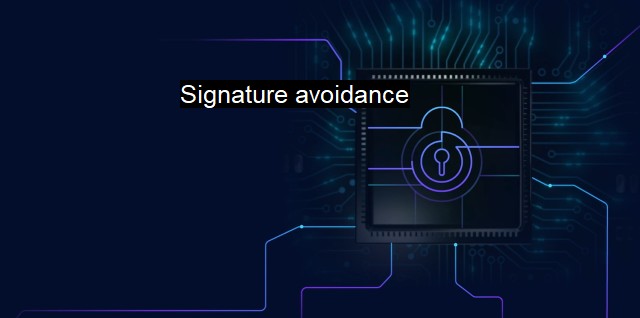What is Signature avoidance?
Exploring Signature Avoidance Techniques: A Common Method Used by Malware to Evade Detection
Signature avoidance is a term used primarily antivirus software, and computer network defense strategies, referring to attempts by hackers or malicious programs to prevent detection by security systems. These security systems typically rely on databases of signatures, which are unique identifying patterns in a malicious code. there are methods to manipulate the characteristics of a malicious program to avoid detection, hence the term 'signature avoidance'.A 'signature' in the context of cybersecurity and antivirus software is a unique pattern or set of rules that algorithms can use to identify viruses, malware, or any other kind of potentially harmful software. Antivirus software producers use these signatures to keep track of known malware and prevent them from causing damage. They regularly update their existing list of signatures to spot newly developed or altered threats.
Signature avoidance is employed by cybercriminals as part of an evolving strategy to bypass security measures. It constitutes a significant evolving challenge for developers maintaining anti-virus software and teams working on cybersecurity, mainly because it makes detection and neutralization of threats difficult.
Several factors make signature avoidance a complex issue. The most prominent one is the nature of malware signatures. These signatures, while relatively distinct, are not entirely immutable or invariable. Cyber attackers who are adept at coding can alter these signatures by making minor adjustments or tweaks using different types of obfuscation techniques. by packing or compressing the malware, its signature is changed enough to bypass some casual scans. Another technique is the use of polymorphic code, which transforms every time it runs while keeping its original function.
These varied methods mean that the attackers can continuously create new, unique signatures for their harmful programs following each attack or use. This tactic enables them to avoid heuristic trap detection and traditional signature-based antivirus schemes, making the destructive programs almost impossible to track or destroy. Even if one iteration of the malware is detected and its signature added to the database, the slightly altered new version that shows up would appear different, thus allowing it to bypass the existing safeguards and enabling the attackers to achieve their malicious intents.
In an even more advanced case, employing metamorphic code makes the malicious program rewrite itself entirely every time it spreads. Cybercriminals can also use encryption and split the offending code into several parts to further complicate its detection. Such advanced strategies underline the efficacy of signature avoidance against standard antivirus protocols.
Strategies like artificial intelligence and machine learning have been employed to counter these avoidance techniques. Advanced Persistent Threat (APT) detection techniques, which are designed to identify complex, multilayered attacks, are also gaining significant traction in the cybersecurity industry.
Signature avoidance is a complex and constantly developing challenge in the cybersecurity realm. By modifying malware to avoid recognizing their unique footprint, attackers challenge the traditional methods of detection and containment. While the cybersecurity industry continues to advance in tackling these evolving threats, understanding the concept and practice of signature avoidance is crucial in this ongoing cyber arms race. Therefore, as a security method against ongoing evasion techniques, organizations and people must continue to remain vigilant, up-to-date, and adaptive.

Signature avoidance FAQs
What is signature avoidance in cybersecurity?
Signature avoidance in cybersecurity is a technique used by malware to bypass antivirus detection. It involves altering the code or behavior of the malware to evade detection by antivirus software which typically relies on signature-based detection.How does signature avoidance work?
Signature avoidance works by modifying malware code or behavior in such a way that it becomes difficult or impossible for antivirus software to recognize it as a threat. This can involve changing the code's structure, using encryption or obfuscation techniques, or taking advantage of vulnerabilities in the antivirus software itself.What are the consequences of signature avoidance for cybersecurity?
The consequences of signature avoidance for cybersecurity can be severe, as it allows malware to go undetected and potentially compromise systems, steal data, or cause other types of harm. It can also make it more difficult for cybersecurity professionals to detect and respond to threats, as they may not be able to rely on traditional antivirus software to identify and stop attacks.How can organizations protect themselves from signature avoidance?
Organizations can protect themselves from signature avoidance by using a multi-layered approach to cybersecurity, including a combination of signature-based antivirus software and other types of detection and response tools. It is also important to keep software and systems up to date with the latest security patches, and to educate employees about safe computing practices and the risks of phishing and other types of social engineering attacks.| | A | | | B | | | C | | | D | | | E | | | F | | | G | | | H | | | I | | | J | | | K | | | L | | | M | |
| | N | | | O | | | P | | | Q | | | R | | | S | | | T | | | U | | | V | | | W | | | X | | | Y | | | Z | |
| | 1 | | | 2 | | | 3 | | | 4 | | | 7 | | | 8 | | |||||||